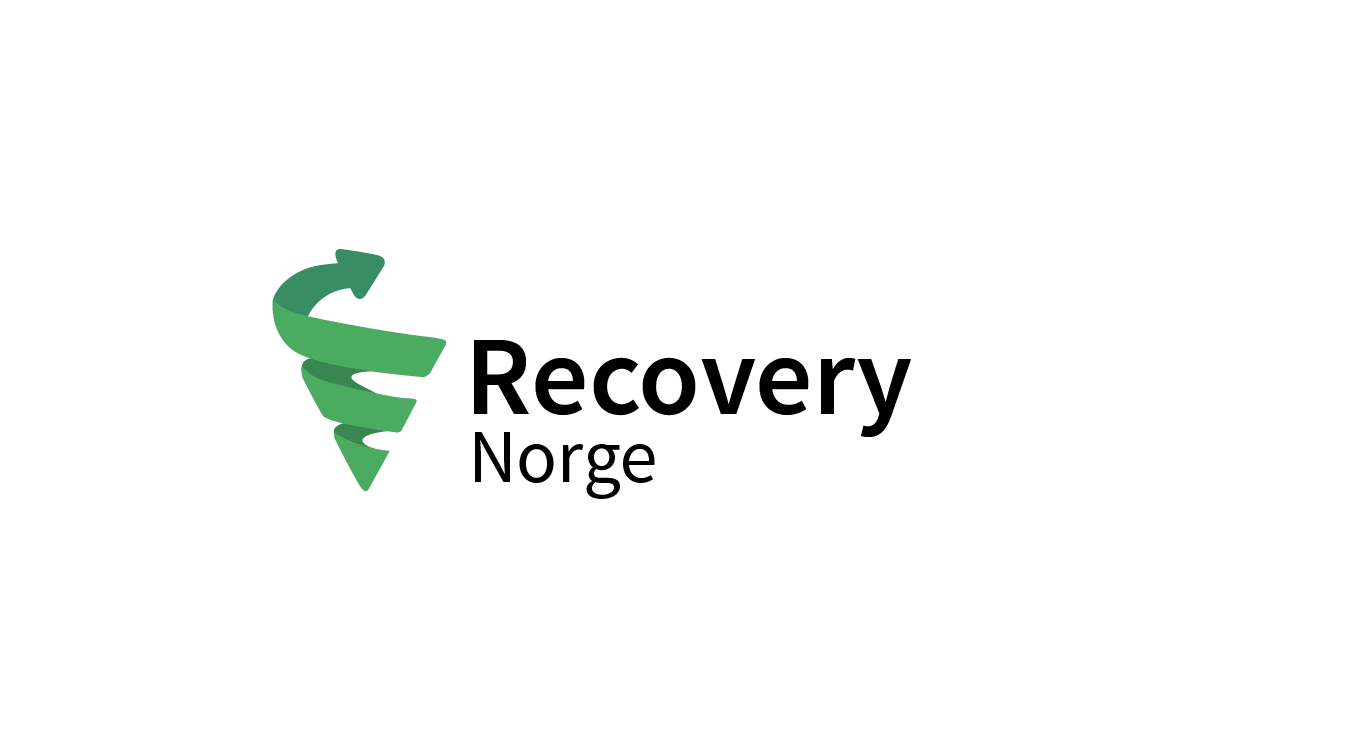Author: Amy Engkjer
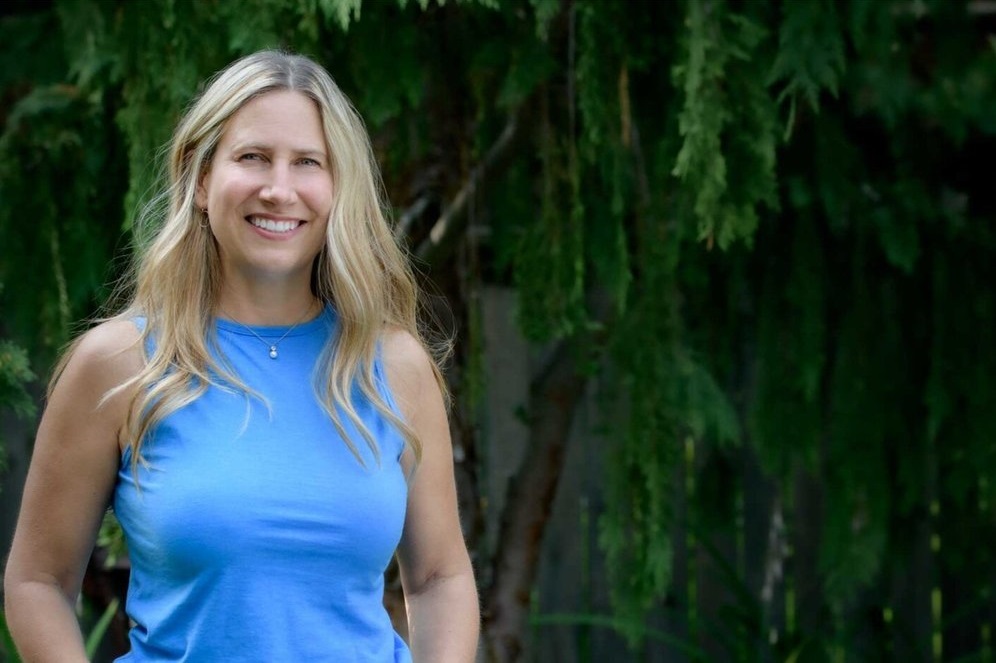
I Have COVID
When I got COVID in the beginning of November 2020, it hit me hard. I experienced over 18 different symptoms, including: fever, cough, loss of taste and smell, intense fatigue and neurological symptoms such as extreme sensitivity to sound and physical sensations, the palms of my hands were numb, and showering was painful. I had three episodes that felt like seizures and frequent stabbing pains in my head. And, I can’t forget the new COVID-flavored migraines; we packed my head with ice bags. I couldn’t think clearly and lost my words all the time. I thought I was going crazy.
But, I wasn’t having shortness of breath, so I didn’t get much attention from my doctors–they just told me to go home and rest.
Getting dressed became an event. Taking a shower was monumental. My husband Cory did everything. Okay, I could wash one dish, take a break for five minutes, then wash another. I could only do things from the waist up because if I bent over I’d almost pass out.
Getting dressed became an event. Taking a shower was monumental
Over the first few weeks, I would rest then try to get back to normal, only to be thrown back in bed after the slightest exertion.
My coping skills were so taxed and I needed every bit of help I could find. Meditation had always been my “go to” but it was beyond my capacity to find any calm within my body or brain. I literally thought I was losing my mind. Luck had it, that I was reading Norman Doidge’s, The Brain That Changes Itself, when I got COVID. The topic of neuroplasticity and how the brain can recover after injury was so pertinent. This definitely gave me a leg up in believing that despite how messed up I felt, I would recover.
I needed to be doing whatever I could to shift from despair to hope. I needed to surround myself with as much positivity as possible. I desperately sought hopeful stories, because the stories in the news were really bringing me down. That is when Positively COVID was born, when I was at my lowest. If I needed, craved, ached for that positivity, I thought that others must need it too.
I Have Long Covid
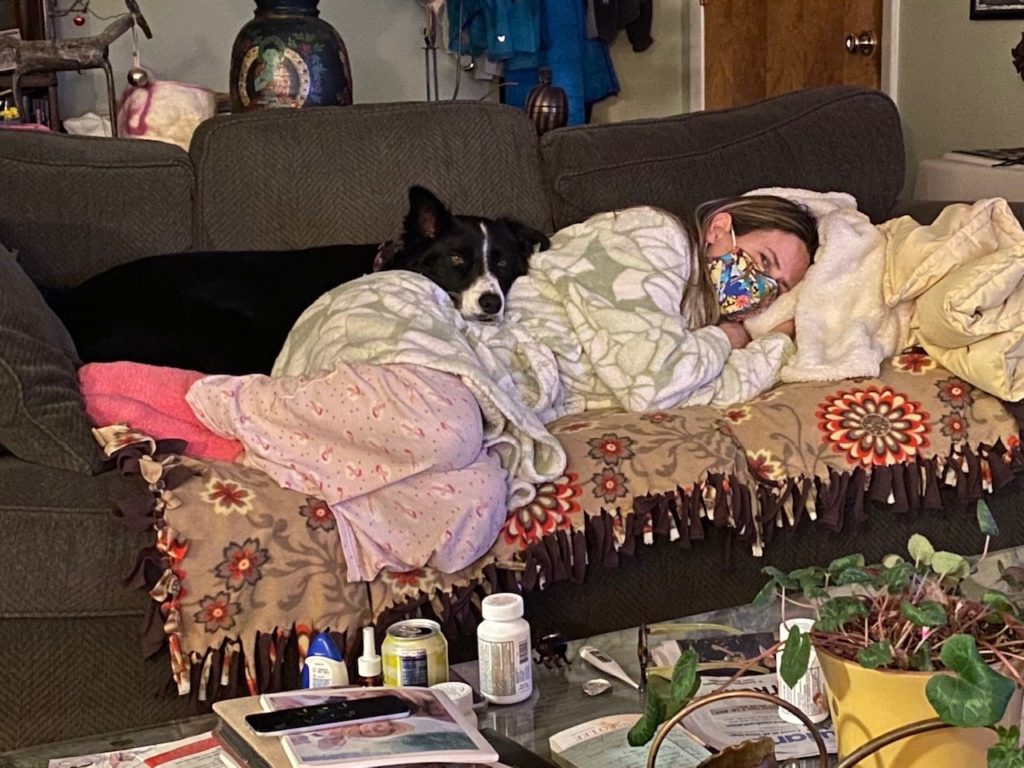
After six weeks, not only did COVID* stick with me, but some of my symptoms got worse and the list got longer: tachycardia (rapid heart rate), dizzy spells, the feeling of a swollen brain (the worst!), frequent episodes of smelling smoke. My scalp was so painful that, for weeks, I could barely rest my head on my pillow (they thought I might have shingles, but no, just COVID). I couldn’t stand for more than 30 seconds without having to sit down. I was diagnosed with dysautonomia: my nervous system was not working as it should, so my body would do things like sweat and have goose bumps at the same time. I was so shaky, especially in the mornings, I could barely hold a pen. I had such trouble sitting upright that we had to use a camp chair with pillows to prop me up so I could eat in front of the TV. Cory was still doing most everything and my 85-year-old father cooked for us once a week. Dear friends helped when they could.
The middle of the night became a new world. The insomnia was unreal. I was awake for at least three hours every night. If I wasn’t fighting bizarre symptoms or freaking out and waking my husband up, I would write or read. At one point I was reading a book a week.
I made peace with the silence.
What Helped Me
I tried to find humor wherever I could. With the shaking so bad, I found my anklet of bells that I got at a Grateful Dead show and put that around my wrist. I thought, “Might as well make some music!”
I had been handed this terrifying yet fascinating set of symptoms to figure out
There were hours here and there when I wasn’t feeling miserable but I was always super fatigued. I had been handed this terrifying yet fascinating set of symptoms to figure out. I thought I was mindful before, but boy, I became so acutely aware of what made me feel good and what didn’t. An elimination diet of life stimulation occurred. If it didn’t please me, I sent it away.
A couple months in, I started a concussion protocol which really helped minimize the stimulation to my brain. I stayed off my phone, limited long conversations and generally tried to give my poor brain a break.
I found that having a routine made a big difference. The four elements that I had to include in each day were:
1) practicing a positive mindset
2) resting
3) nourishing myself and
4) moving
Even if that only meant trying to smile, taking a bath, eating something healthy and taking a five-minute walk (which I made sure to do every day). This basic routine kept body and soul together.
Another one of my “early in the journey” books was, Anatomy of a Patient by Norman Cousins, which reminded me how important it was to believe in my own recovery and to laugh. So, my brain training continued.
Believe and laugh.
Though most days, I had to dig really deep to access any positivity, I stuck to my commitment.
This also led to making a point to tell my doctors that I planned on making a full recovery and if they weren’t on board, we probably weren’t the right fit. I understood that there were so many unknowns with this novel virus but I couldn’t allow that to affect the belief in my recovery. I built my team of doctors and practitioners, based on this fundamental approach.
Hell and Back and Hell and Back, Again
I had been to hell and back a few times in my life before I got COVID. I lost my brother to sudden, tragic death and my mother to a sudden death. It is hard to explain to people, but having COVID was 10 times harder than those events, combined. I have never experienced that much physical and mental anguish. And it was unrelenting. Day after day, week after week, month after month. I was facing my own mortality.
Would the life I had known ever exist again?
I began having what we called “hell surges”, and bouts of psychosis . . . moments of crying uncontrollably for hours. Despite believing I would recover, the doubt would hit like a tidal wave. I was so terribly worried that I would never recover.
Despite believing I would recover, the doubt would hit like a tidal wave. I was so terribly worried that I would never recover.
Each time, I tried to replace this worry with hope.
I would ‘change the subject’ by going for a walk, or doing some form of “joy shocking” like laughing my ass off, or burying my face in the fur of one of my dogs, to get out of a negative pattern. And over time, it gained traction.
There were days when I would be cruising along and then this intense physical surge would happen, followed by the darkest, sickest thoughts you can imagine.
Most often, a couple of hours would pass and it was as though I could look back on the episode as if it were a scene in a movie. But there were other times that it lasted longer, sometimes weeks of feeling down, with just more intense surges of despair scattered throughout.
It seemed logical to end my life during those periods.
Every moment, I tried to gently, lovingly show myself the way.
As I mentioned, I struggled to return to my daily meditation practice. My body was so uncomfortable and my brain was all over the place (way more than normal). But, I persevered and eventually I was able to sit for just a few minutes at a time.
I did everything I could possibly do to get better. I regularly saw a neurologist, and a physical therapist. I did Neurofeedback, which definitely helped to stabilize my brain. I practiced an anti-inflammatory diet, got shiatsu, worked with NLP (neuro linguistic programming), EMDR, (eye movement desensitization and reprocessing), even took ice cold showers.
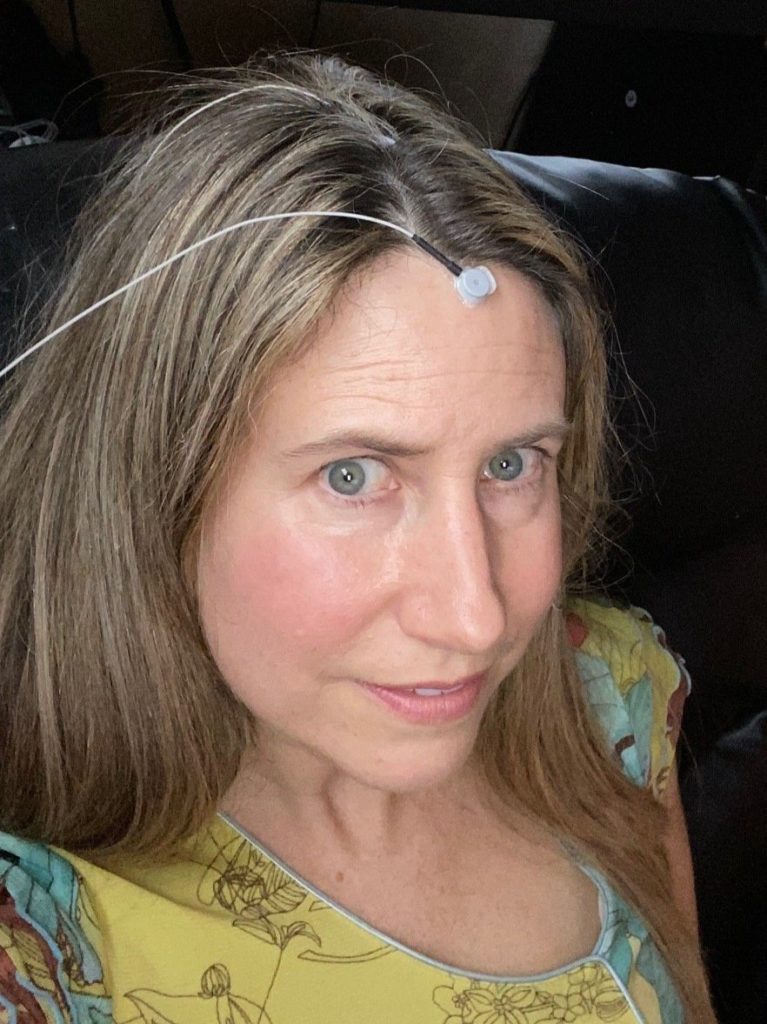
The hell surges went from 20 a day to 3!
Everything helped just a little bit. I was keeping myself on the right trajectory. But damn it was slow. I have never had to practice such patience before.
I had to focus on quieting the noise for my extra sensitive nervous system. I was a sensitive being to begin with, but I embraced this new sensitivity and used it to become more aware of how I was reacting to any stimulus. I learned to pay close attention to what made my heart race and when to take a step back. I realized that every moment needed to be met with awareness and kindness, in order to make a positive choice. Otherwise the symptoms would bury me.
I realized that every moment needed to be met with awareness and kindness, in order to make a positive choice
I remained fascinated by the neuroscience of pain and neuroplasticity. COVID illness and recovery is so multifaceted: the actual virus that insults the body, psychological trauma, stress, and the horrific negativity one is exposed to in the news, social media and quite possibly, one’s own community.
I kept on gently, lovingly showing myself the way.
And I was grateful for the resources I had to help me, knowing not everyone has those resources, but also knowing that so much of the power to heal was and is within me.
A Break in the Storm
As winter turned to spring then summer, the hell surges subsided and the COVID dread diminished. I began to venture out of the house more and enjoy Missoula’s summer. I got out and fished once or twice, but could only do it for a few minutes.
I had an entirely new appreciation of life. I even took a trip to DC! I felt pretty good but could never push myself too far. And then, wildfire smoke blanketed the Missoula Valley. It was as though I went back to square one. The symptoms came back full force and this time, the anxiety was debilitating.
I had to remind myself to move at my own pace. Journaling about my daily activities and being able to see where my stress was triggered, was a big help. And, I made a commitment to no longer operate at the pace that society imposes. This shifted my perspective on how I moved through my days. I again began improving, a lot
I was at about 95% but still having some mini setbacks.
It’s important to note some things here: pacing helped me slow down, take note and recognize when I was being triggered. For example, when I eliminated stairs for a while, I made great strides in my recovery. That said, I also believe I became hyper-sensitive to my symptoms, and it fed the beast. I think pacing is a fine line for everyone. You must determine for yourself where that line is between being aware of what might inhibit your progress and also pushing yourself when triggers come up that might keep you in a looping system (read on for more insight on that). One definitely needs the initial rest and re-set, then comes the good stuff!
COVID Recovery: Positivity Wins!
Then came a two-week period that changed everything. I had arrived at a new level of being “sick and tired” of all the appointments (average 3/week) and supplements that were cluttering my countertop.
I googled “Dr. with COVID,” because I really wanted to hear a story of a doctor who had dealt with Long COVID, personally. I read Dr. Paul Garner’s recovery story and how he realized that he needed to reprogram his brain to get out of a heightened nervous system loop. The next day, I listened to a couple of Nicole Sachs’ podcasts, which further clarified how we protect ourselves with pain, as a diversion. That SAME week, I did a five-hour session with a NLP practitioner to change the language and thoughts my brain was cycling.
I realized that I had the power to break this cycle
WHAM! It all came together. Everything shifted.
I realized that I had been in a looping system. After the trauma my body had been through, I remained in a heightened state of stress, and it didn’t take much to get triggered.
I realized that I had the power to break this cycle.
At the end of that week, my therapist asked me “what will you do with the rest of your day?” Typically, I would’ve said “go home, take a bath, get a little work done, take a break.”
This day happened to be gorgeous outside and I said “I want to hike up a mountainside.”
She said “then do it.”
And I did! I felt amazing.
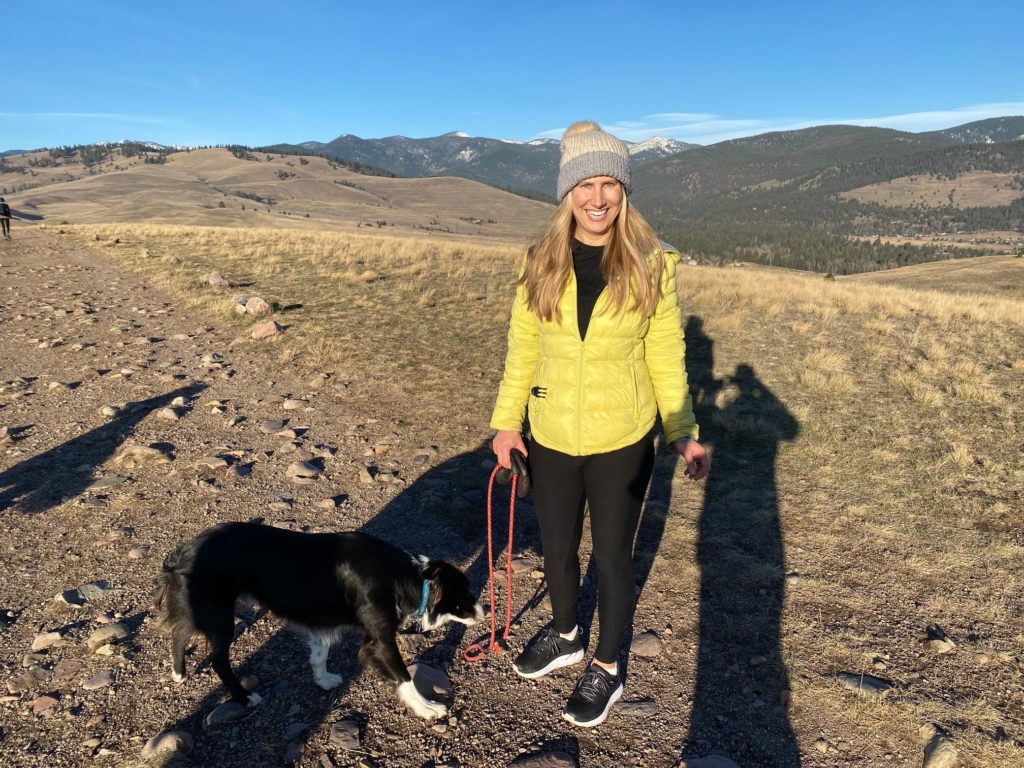
After one year and 10 days I realized that I was done with COVID!
The mind-body connection was the final piece in my healing from a very real disease. I had to:
Pause
Listen to my body
Notice the habitual reaction to my symptoms
Note that my body was in a sustained fight or flight pattern that created false fatigue alarms
Interrupt this pattern
Override it with a healthy, positive message (You are okay! All is well)
Then, I had to let time pass.
It didn’t take long to re-create a new healthy pattern. There was some pushback at first, but it only took a couple weeks for my body to fully get the message.
I had known for some time that I had the ability to recognize an unhealthy pattern, interrupt it and create a new habit; I just never knew I would have to practice it at this level. It’s hard to simply override the messages that our bodies are sending to “keep us safe.” By watching the symptoms arise and talking myself through it with positive, compassionate language I was able to retrain my brain and create new neural pathways.
Having only heard negative stories, that was what my body believed.
Once I knew there was another way, it opened a door. It was like finally jumping off the high board at the community pool. And once I did, it was great.
I wanted to shout out to everyone “Come on in, the water’s fine!”
What I Learned
I know all of the positive mindset training, good nutrition, rest, movement, and helping others played a significant role in my recovery. It also prepared me to allow the shift to full recovery, and bolstered me to live the best life ever!
I can do ANYTHING now.
I am traveling, hiking, working out . . . dancing. The future’s so bright.
Looking back, it is hard to distinguish where the virus ended and where the hyper-sensitive nervous system response began. But I know it is crucial for people to start practicing a positive mindset and nurture their nervous system while they are very sick, it may help prevent them from getting into this awful looping system in the first place. It takes a lot to endure a novel virus, to cope physically and psychologically, but it’s possible.
I know that the trauma I experienced has allowed me to grow and change into something I could never have imagined.
I want to make clear that “positivity” doesn’t just mean smile your discomfort away, or that it’s all “in your head”
I want to make clear that “positivity” doesn’t just mean smile your discomfort away, or that it’s all “in your head.” But, it is a beautiful way to access the deeper compassion, patience, acceptance, love and understanding you’ll need to face intense physical pain and mental anguish.
My COVID illness was not only one of discomfort but became a season of beautiful self-exploration, deep social connection and more. When I was able to pause–possibly having interrupted a painful moment–and strip everything down to the simple essence of the moment, then start moving forward again with love, patience and trust, each new moment was colored anew.
Take Away
We can overcome Long COVID!
We can do this by learning and understanding how our nervous systems function, and how, by no fault of our own, our bodies can get into a heightened stress pattern. This stress pattern, if left unchecked, can get pushed over the edge into dysregulation and disorder and become chronic.
But there is another route: through awareness, we can interrupt this pattern, and show ourselves the way by deliberately moving through our lives with positivity, gratitude, kindness and humor. We can sooth our nervous system through mindful loving attention, choosing the thoughts and language we use and by interacting compassionately with the world. In doing so, we will not only regain stability, we flourish.
* In this text, Amy used the term COVID to describe the illness both before and after the acute phase. It is important to note that covid-19 is an infectious disease. There is no evidence that persistent infection is the cause of the prolonged symptoms. – Recovery Norway.
Amy Engkjer is the founder of the nonprofit Positively COVID. Follow this link to learn more!
